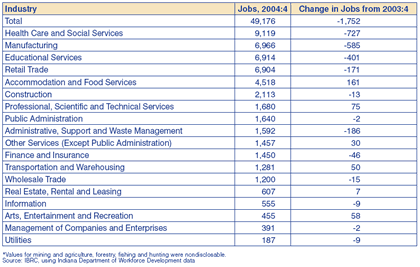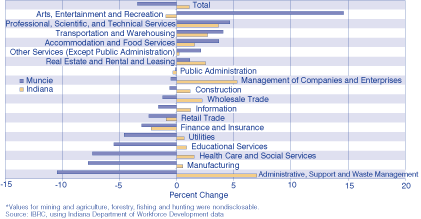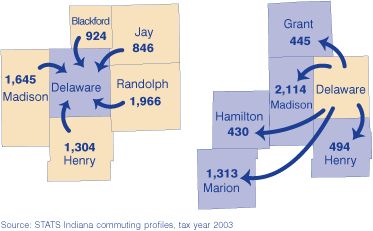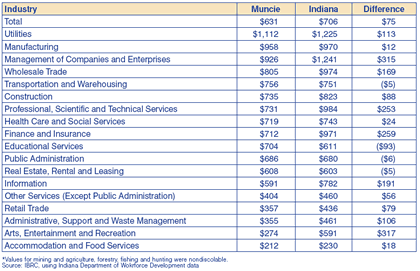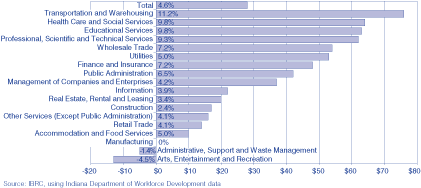The Muncie Metro Area
Delaware County, located in east central Indiana, is home to the Muncie Metropolitan Statistical Area (metro) and has a population of 117,774, as of the 2004 estimates. Since 2000, Indiana has grown by 2.4 percent while the metro has lost about 900 residents—a decline of 0.8 percent. The city of Muncie’s 2004 population surpassed 67,000, accounting for 57 percent of the county’s population.
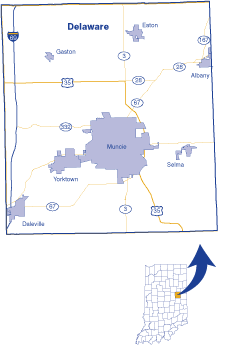
Population projections from the Indiana Business Research Center calculate that, by 2020, the Muncie metro will have added about 8,200 residents, a 6.9 percent growth from its 2000 population. That isn’t bad, considering it is just a few percentage points lower than the state’s anticipated population gain (10.9 percent). However, the county has not, thus far, kept pace with its expected growth. To catch up to its projected 2005 population, the county would need to add nearly 3,200 people in the coming year—a far cry from the nearly 700-person decline experienced between 2003 and 2004.
Industrial Mix and Jobs
People are not the only thing Muncie has been losing lately. Between the fourth quarters of 2003 and 2004, total payroll employment declined by 1,752 jobs, or 3.4 percent, according to the Covered Employment and Wages data set from the Indiana Department of Workforce Development.
As shown in Table 1, Muncie’s largest sectors include health care and social services (18.5 percent), manufacturing (14.2 percent) and educational services (14.1 percent). These three industries experienced the largest numeric employment declines between 2003 and 2004:
Table 1: Muncie Metro Jobs by Industry
- Health care and social services: -727 jobs (-7.4 percent)
- Manufacturing: -585 jobs (-7.7 percent)
- Educational services: -401 jobs (-5.5 percent)
Administrative, support and waste management had the largest percentage drop with a 10.5 percent decline, equivalent to 186 jobs.
Industries with the largest job gains in Muncie between 2003 and 2004 included professional, scientific and technical services (75 jobs, or 4.7 percent), arts, entertainment and recreation (58 jobs, or 14.6 percent), and transportation and warehousing (50 jobs, or 4.1 percent). Moreover, of the six industries that increased in employment, five grew at a faster rate in Muncie than they did statewide (see Figure 1).
Figure 1: Percent Change Employment by Industry, 2003 to 2004
Cardinal Health System and Ball State University are two major employers in the region. General Motor’s Manual Transmissions plant has been a significant player in the local economy since it opened in 1935 (then dubbed Chevrolet-Muncie). However, its workforce shriveled last year, and GM recently announced the plant will completely shut down at the end of March 2006. (1) On the positive side, a new $55 million Magna DriveTrain plant is planned with the potential for employing around 300 workers by 2007. However, since the plan was announced in 2004, the product line that was to be manufactured at the facility has been moved elsewhere; so, while the company has assured the city that it will continue with the plant as planned, the products to be manufactured are still unknown. (2)
New job creation has dropped slightly each year since 2001, according to Local Employment Dynamics (LED) data from the U.S. Census Bureau. The average quarterly new job creation for 2001 was almost 3,300. The average for 2003 was nearly 1,000 less at 2,363 new jobs created. Nearly 1,950 new jobs were created in Muncie during the first quarter of 2004 (the latest data available).
Commuting
Figure 2 shows that Randolph County sends the most commuters into Delaware County, while Delaware County itself sends the most commuters to the neighboring Anderson metro (Madison County). Despite fewer employment opportunities as evidenced by declines in total employment, the Muncie metro still has more people commuting into the county (9,853) than it has residents leaving to find work in neighboring counties (6,679), according to the preliminary commuting data for 2003.
Figure 2: Delaware Commuting, 2003
Wages and Compensation
The average weekly wage in Muncie for the fourth quarter of 2004 was $631. This was up $28 over the same quarter of the previous year, but still $75 less than the Indiana average. As seen in Table 2, four Muncie area industries exceeded the statewide industry average: educational services, public administration, real estate, and transportation and warehousing.
table 2: Weekly Wages in Muncie and Indiana by Industry, 2004:4
Wage growth at the industry level shows that only arts, entertainment and recreation and administrative, support and waste management had average wage declines between 2003:4 and 2004:4. Transportation and warehousing saw the largest jump in wages with an 11.2 percent increase of $76. Health care and educational services were next in line, with a 9.8 percent growth of $64 and $63, respectively (see Figure 3). Thus, some of the largest increases in average wage occurred at a time when employment was decreasing. This is likely to be partly due to productivity enhancements resulting in higher wages. However, another factor could be layoffs of the employees with the least seniority, who also happen to be the lowest-paid.
Figure 3: Change in Average Weekly Wage, 2003:4 to 2004:4
Looking at total compensation, including employer-payments for pensions and insurance, the average compensation in Muncie for 2003 (latest data available) was $37,030, a 10.8 percent increase from two years earlier (2001). While average compensation per job was about $4,400 lower than in the state as a whole, it increased at a slightly faster rate between 2001 and 2003. The bulk of this increase did not show up in the pockets of Muncie employees, per se, but is attributable to higher contributions to pension and insurance funds, where spending increased 39 percent.
Notes
- Rick Yencer and Michael McBride, “GM sets Muncie’s Manual Transmissions plant shutdown for March, 2006” Star Press 2 August 2005. .
- Keith Roysdon, “Road work shows officials confident plant is still coming” Star Press 24 August 2005.
Indiana Business Research Center, Kelley School of Business, Indiana University

